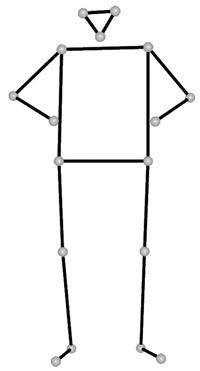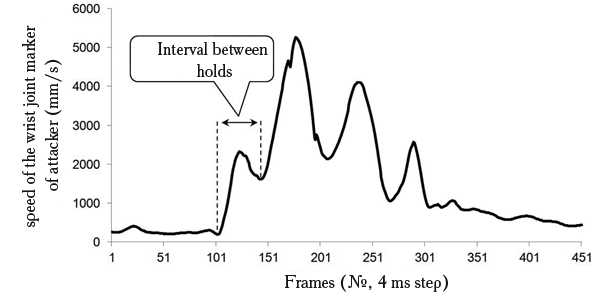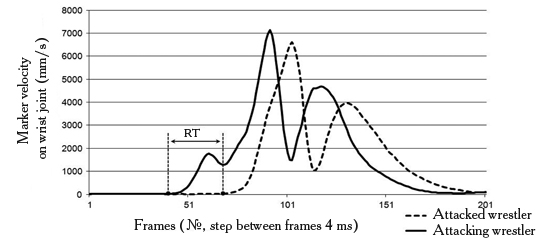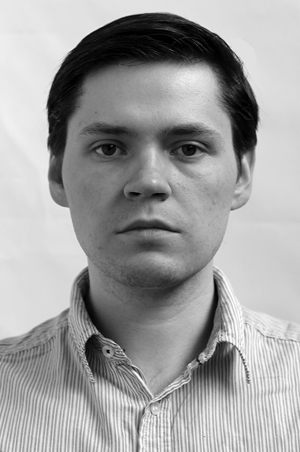Measurement Procedure of Specific Motor Response Time of Combatants Based on Three-Dimensional Kinematic Analysis
Фотографии:
ˑ:
A.A. Shipilov, junior researcher
Research institute of sport of Russian state university of physical culture, sport, youth and tourism (SCOLIPC), Moscow
A.Yu. Vagin, Ph.D.
Russian state university of physical culture, sport, youth and tourism (SCOLIPC), Moscow
Key words: response time, martial arts, three-dimensional kinematic analysis.
Introduction. Measurement of time of specific motor responses of combatants is associated with a number of methodological difficulties. Firstly, it is the creation of hardware and software methods of stimulation, time keeping and registration of subject’s responses. Secondly, depending on the objectives of the study, it is modeling of various conditions of the duel and, above all, modeling of an opponent and his single actions.
First devices created to register motor responses in martial arts were electromechanical [3]. Flashing of bulbs was used as a stimulus and performance of the task was fixed with closing a contact. Nowadays, the most advanced in this area are the measuring systems that use virtual reality technologies, which help to model the three-dimensional environment and opponent’s actions to the maximum extent feasible, i.e. help to create specific stimuli for a particular sport [4, 5].
For example, Witte K., Emmermacher P. et al in their study of karatekas’ response time used the virtual reality system CAVE (Cave Automatic Virtual Environment). We used the karateka model animated using the VICON optoelectronic system, namely the model’s actions were exactly the same as the actions of a real athlete, as a virtual opponent, whose actions the subject had to respond to [7].
The studies of the actual athletes' interaction are an alternative of the comprehensive three-dimensional modelling. It is possible thanks to modern optoelectronic systems and programs of kinematic analysis, ensuring measuring the subject's responsiveness to actions of a real opponent without modelling [6]. The main advantage of the quoted approach is the fact that the experiment takes place under the conditions very close to the ones of a sports combat and the subject reacts to stimuli specific for his sport.
The purpose of the study was to approve the measurement procedure of specific motor responsiveness of combatants based on the three-dimensional kinematic analysis.
Athlete's response time when interacting with a real opponent is measured by determining: the moment of onset of an attack and the moment of onset of a counter-action - the interval between them is response time. Therefore, the main objective of the experimental part of our study is to identify a reliable criterion for precise temporal locality of these moments.
Materials and methods. The optoelectronic system for three-dimensional motion analysis Qualisys was used as measuring equipment. The system action is as follows. Special infrared cameras were set around the subject who performs a motor task, - they define three-dimensional coordinates of markers reflectors attached to his body with the frequency of 250 Hz. The data obtained using the software Qualisys Track Manager is useful when calculating the motion kinematic characteristics for each marker: distance, velocity, acceleration. We used a set of 17 markers, fixing them on shoulder, elbow, wrist, hip, knee, ankle, first metatarsophalangeal joints. The markers were also attached to the head: left and right temples, chin. Joined together, the markers form an animated multilink model, which provides detailed information about the subject’s actions (Fig. 1).

Fig. 1. Mulilink model of subject’s body
It should be noted that the above methodology involves the use of lightweight and compact marker reflectors (sphere diameter 19 mm), and thus provides the needed freedom of action for subjects.
The paired exercise used in karate training to develop speed qualities was a motor task for the subjects. The essence of the exercise is as follows. The attacking and defending roles are defined in a pair of athletes, then the opponents take up their positions: facing each other in a left fighting stance. A target is placed between them in the form of light "claw-racket" that is held by an assistant, who stands perpendicularly to the line of the combat cooperation. The distance to the target is the same for both of the subjects. After announcing the command "start" the attacking athlete, choosing the moment himself, performs the impact action "tsukkomi gyaku tsuki" on the claw, and the attacked wrestler should quickly react with exactly the same impact action on the same target, but from his side. The attacked wrestler knows in advance exactly how the opponent will act and how he should respond, so his responses can be classified as a simple reaction [2].
As a part of our experiment the attacking athlete had 15 seconds to independently choose the moment of attack in each attempt after the tester’s command "start", which thus provides an element of surprise for the attacked wrestler. According to the experimental conditions, the actions performed by an attacked athlete should not have contained preliminary or feigned actions. In all, the attacking athlete held 10 attacks, after which the subjects changed their roles and were retested. 4 athletes aged 20 to 24 years, competing in karate (WKF version) and ranked as Masters of Sports, participated in the experiment. To maintain the experimental integrity they were paired according to their weight category (Table 1).
Table 1. Anthropometric data of the subjects
|
|
Subject №1 |
Subject №2 |
Subject №3 |
Subject №4 |
|
Height (cm) |
177,7 |
181,0 |
184,3 |
185,8 |
|
Weight (kg) |
67,3 |
70,1 |
75,6 |
78,2 |
Results and discussion. Right before a motor task the subjects are in a stationary position, so the most obvious and reliable indicator of the onset of an attack and the onset of counter-actions is to change the coordinates of one of the markers attached to the striking arm. We’ve chosen a marker on the wrist joint to analyze it. However, in this case, the tester is to determine for each individual record along which of the three axes the movement has started earlier. This index may vary depending on the individual characteristics of the subject’s technique and also on his location relative to the general coordinate system, which is assigned by the measurement system. In addition, it should be noted that due to the high shooting frequency the visual analysis of displacement diagrams is not very effective, since the onset of a motion is shown on them with minimal changes that can be hardly identified (Fig. 2). Thus, the tester has to handle an array of values the diagram is made of to accurately determine the appropriate moment.

Fig. 2. The diagrams of dislocation markers (axis Y, running parallel to combat interaction), attached to the wrist joint of the striking arm of attacked and attacking wrestlers. The onset of attack and counter-actions is marked on the diagrams. The interval between the marks - response time (RT) of attacking wrestler.
Therefore, a it was resolved to use another criterion – velocity (of the same marker), which is an integral indicator reflecting the marker movement along all three axes. Having analyzed the velocity diagrams, we found a common pattern for all subjects: the beginning of attack and counter-actions is characterized by a sharp rise in the diagram relative to the zero contour (Figure 3), which in most cases helps to locate the desired time using only visual analysis. It has been found that the onset of action, defined using the velocity diagram, coincides with the time determined by the displacement diagram, that indicates the reliability of the chosen criterion (Fig. 2, 3).

Fig. 3. The velocity diagrams of markers, attached to the wrist joint of the striking arm of attacked and attacking wrestlers. The onset of attack and counter-actions is marked on the diagrams. The interval between the marks - response time (RT) of the one who attacks.
We calculated the response time for all subjects in each of the shot attempts using the identified criteria. The results are shown in Table 2.
The range of response time, displayed by the subjects in the experiment (167,2-184,0 ms), corresponds to the range of time of human simple response to a visual stimulus ( 150 - 224 ms), which also confirms the reliability of the chosen criterion [1].
The present study concerns measuring latency of a simple reaction as an example. The technique ensures measuring the time of the latent period and the duration of the motor component of various types of complex response, promoting the potentials for researching the peculiarities of responses of combatants to various technical and tactical actions.
Further researches and automatization of the kinematic analysis are assumed to facilitate the application of such technologies not only as research methods, but as a method of assessment of the athletes' speed and power fitness and in educational monitoring.
Table 2. Response time shown by subjects in the experiment
|
Attempt № |
Response time (ms) |
|||
|
Subject №1 |
Subject №2 |
Subject №3 |
Subject №4 |
|
|
1 |
172 |
160 |
232 |
184 |
|
2 |
164 |
180 |
164 |
168 |
|
3 |
184 |
156 |
208 |
152 |
|
4 |
128 |
168 |
212 |
156 |
|
5 |
180 |
208 |
168 |
196 |
|
6 |
184 |
164 |
188 |
160 |
|
7 |
164 |
172 |
176 |
180 |
|
8 |
176 |
216 |
172 |
164 |
|
9 |
176 |
172 |
156 |
192 |
|
10 |
144 |
212 |
164 |
192 |
|
|
167,2 |
180,8 |
184,0 |
174,4 |
|
σ |
18,3 |
22,6 |
25,2 |
16,4 |
References
- Boyko, E.I. Human response time / E.I. Boyko. – Moscow: Meditsina, 1964. (In Russian)
- Nikandrov, V.V. Psychomotor system: study guide / V.V. Nikandrov. – St.Petersburg: Rech, 2004. – 104 P. (In Russian)
- Farfel’, V.S. Motion control in sport / V.S. Farfel’. – 2nd ed., ster. – Moscow: Sovetsky sport, 2011. – 202 P. (In Russian)
- Bideau, B., Multon, F., Fradet, L., Arnaldi, B., and Delamarche, P. Using virtual reality to analyze links between handball thrower kinematics and goalkeeper's reactions // Neuroscience Letters. 2004. V. 3 (72). P. 119-122.
- Chuanjin, L. Research on application and development of competitive sport simulation based on virtual reality technology // Advanced Material Research. 2011, pp. 179-180, pp. 1063-1068.
- Owings, T.M., Lancianese, S.L., Lampe, E.M., Grabiner, M.D. Influence of ball velocity, attention, and age on response time for a simulated catch // Medicine and Science in Sports and Exercise. 2003. V. 35 (8). P. 1397-1405.
- Witte, K., Emmermacher, P., Bandow, N., Masik, S. Usage of virtual reality technology to study reactions in karate-kumite // International Journal of Sport Science and Engineering. 2012. V. 6 (1). P. 17-24.
Author’s contacts: Tabularasa86@yandex.ru



 Журнал "THEORY AND PRACTICE
Журнал "THEORY AND PRACTICE